ZEN IRODALOM ZEN LITERATURE
« Zen főoldal
« vissza a Terebess Online nyitólapjára
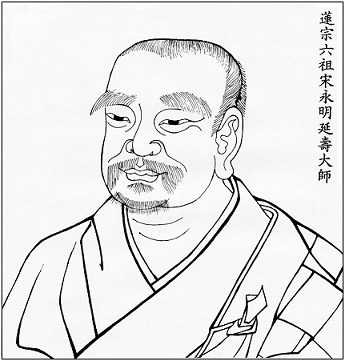
永明延壽 Yongming Yanshou (904–975)
宗鏡錄 Zongjing lu
(Rōmaji:) 永明延寿 Yōmyō Enju: 宗镜录 Sūgyō roku
(English:) Records of the Source Mirror / Record of the Mirror of Orthodoxy / Source Mirror Record /
Record of the Axiom Mirror / Record of the Mirror of the Tradition
(Magyar:) Kútforrásnak tüköre*
Traditionally accepted as originally issued in the 1st year of the Jianlong era of the Song (960). Also called Xinjing lu 心镜录 (Record of the Mind Mirror).
*©Terebess Gábor
Bibliography
Editions of the Zongjing lu 宗鏡錄 (100 fascicles)
Zongjing lu 宗鏡錄 (100 fascicles). Vol. 48–2016.415a–957b. Based on the Taishō Tripitaka no. 2016 「大正新脩大藏經」 CBETA. Taipei: www.cbeta.org.
Zongjing lu 宗鏡錄. In Taishō shinshu daizōkyō 大正新脩大藏經 , ed. Takakusu Junjirō 高楠順次郎 . Vol. 48–2016.415a–957b. 1st ed. Tokyo: Daizō shuppan kai, 1928; reprint, 1976.
Zongjing lu 宗鏡錄. 8 vols. Taipei: Xinwenfeng chubanshe, 1990.
Zongjing lu 宗鏡錄. 4 vols. Xi'an: Xi'an daxue chubanshe, 2006.
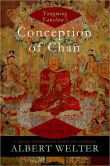
Albert Welter (1952-)
PDF: Yongming Yanshou's Conception of Chan in the Zongjing lu: A Special Transmission within the Scriptures
New York: Oxford University Press: 2011, 381 and x pages.
http://www.oxfordscholarship.com/view/10.1093/acprof:oso/9780199760312.001.0001/acprof-9780199760312
Table of Contents
Introduction
Chapter One - Yongming Yanshou and the complexities of Chan identity
Chapter Two - Revealing the Implicit Truth: Yongming Yanshou's Notion of Zong in the Zongjing lu
Chapter Three - Establishing the Chan Zong: Yanshou's Notion of Chan in the Zongjing lu
Chapter Four - Yanshou and Chan Lineages: An Overview of Chan Sources and Chan Patriarchs in the Zongjing lu
Chapter Five - The Teachings of the Patriarchs: A Study of Chan Lineage Fragments in the Zongjing lu
Chapter Six - The Buddhist School of Principle and the Early Song Intellectual Terrain
Translation of the Zongjing lu, Fascicle One
Abbreviations
Notes
BibliographyAbstract
Yongming Yanshou (904–975) has had a profound impact on the development of Buddhism in East Asia. Although Yanshou is known for his prolific output and wide-ranging scholasticism, Welter's study is the first in a Western language to address Yanshou's significance as a Chan master and provide a sustained analysis of an important aspect of his most significant work. In addition, by isolating the Chan fragments contained in the Zongjng lu (literally, Records of the Source-Mirror), and through comparisons of these Chan fragments with other leading Chan works of the period, the Zutang ji (Anthology of the Patriarch's Hall) and Jingde Chuandeng lu (Record of the Transmission of the Lamp compiled in the Jingde era), this study provides valuable insight into the development of Chan teaching at a critical phase in its development. As a result, the book is the first major attempt to change the generally accepted view of post-Tang Chan Buddhism—restoring Yanshou as a Chan master and as a widely influential proponent of a scripture-based Chan (in opposition to the rhetorical and iconoclastic Chan of the Linji school). In addition to analyzing an important aspect of Yanshou's magnum opus, the Zongjing lu, the book provides a complete, annotated translation of the first fascicle, and translations of numerous Chan fragments throughout. By suggesting Yanshou as an advocate of a Buddhist School of Principle, the book provides a new and exciting paradigm for Song intellectual history.
"Albert Welter has produced his third consecutive outstanding book in recent years documenting the history of Chinese Chan Buddhism during its formative period. In this volume, he treats the crucial figure, Yongming Yanshou, with great skill and insight. The historical materials are compelling, the sources and citations are first-rate, and the translations are reliable and readable. This is another must-read for scholars and students of the Chan school."
—Steven Heine, Professor and Director of Asian Studies, Florida International University"In this landmark work, Welter restores Yanshou to his rightful Chan identity, redeeming him from marginalization as a non-Chan scholastic or Pure Land-Chan syncretist; and positions him as the mainstay of a Song 'Buddhist School of Principle' alongside the 'Linji Chan Mind School.' Welter also brings to light invaluable Chan materials from the extensive Zongjing lu that have long been ignored. In highlighting the existence of a 'principled' Chan, the book breaks new ground."
— Jeffrey L. Broughton, author of Zongmi on ChanPDF: Beyond Lineage Orthodoxy: Yongming Yanshou's Model of Chan as Bodhisattva Cultivation
Chung-Hwa Buddhist Journal (2013, 26: 1-31) New Taipei: Chung-Hwa Institute of Buddhist Studies
http://enlight.lib.ntu.edu.tw/FULLTEXT/JR-BJ001/bj001390672.pdfPDF: Yongming Yanshou: Scholastic as Chan Master
in Steven Heine; Dale Wright, Zen Masters, Chapter 3, New York, 2010, pp. 59–89.PDF: The problem with orthodoxy in Zen Buddhism: Yongming Yanshou's notion of zong in the Zongjin lu
(Records of the Source Mirror)
Studies in Religion / Sciences Religieuses 31/1 (2002): 3-18.
http://www.wlupress.wlu.ca/Journals/sr/issues/31_1/welter.pdfThe practice of Zen Buddhism in Japan, Chan Buddhism in China, and its counterparts in Korea and Vietnam bear little resemblance to the way this form of Buddhism is often characterized ideologically. The present study explores some of the premises of “moderate” Chan, which forms the basis for Chan/Zen as an institutional religion operating within the larger Buddhist world of East Asian societies. In particular, the study addresses the notion of zong in the Zongjing lu (Record of the Source Mirror), compiled by Yongming Yanshou (904-975), one of the leading representatives of “scholastic” (wenzi) Chan and a key figure in articulating the “moderate” Chan position. The study suggests how the definition of contemporary Zen orthodoxy has been dominated by representatives from the “rhetorical” Zen tradition, creating a disjuncture between our intellectual understanding of Zen and the principles guiding its actual practice.
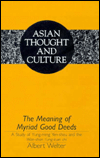
Albert Welter (1952-)
The Meaning of Myriad Good Deeds: A Study of Yung-ming Yen-shou and the Wan-shan t'ung-kuei chi
Asian Thought and Culture Series, no. 13. New York, Bonn, et. al.: Peter Lang Publishing Inc.: 1993, 266 and xiii pages (revised doctoral dissertation).
This book investigates the world of medieval Chinese Buddhist thought at a time when the efficacy of Buddhist practice was being openly questioned. It reviews the life and times of Yung-ming Yen-shou (904-975), a leading figure in the restoration of Buddhism and the principle architect of post-T'ang Buddhist practice. It focuses on the Wan-shan t'ung-kuei chi (Treatise on the Common End of Myriad Good Deeds), a work which has long been credited with providing theoretical justification for the combined practice of Ch'an meditation and activities aimed at rebirth in the Pure Land. The present study offers evidence on how Yen-shou and his Treatise have for centuries been subjected to sectarian bias, clarifying our understanding of the man and his work.
PDF: Welter, Albert Franklin, "The Meaning of Myriad Good Deeds: A Study of Yung-ming Yen-shou and the Wan-shan t'ung-kuei chi ("Treatise on the Common End of Myriad Good Deeds")" (1986).
Open Access Dissertations and Theses. Paper 2185.
http://digitalcommons.mcmaster.ca/opendissertations/2185Abstract
Yung-ming Yen-shou (904-975) was a Buddhist monk who lived in a period of broad changes in Chinese society and Buddhism. He played a leading role in the restoration of Buddhism in the Wu Yüeh kingdom, and left a large body of writings. One of his best known works, the Wan-shan t'ung-kuei chi, has long been cherished by the tradition for its advocacy of harmony between Ch'an meditation and Pure Land practice. The dissertation questions the association of Yen-shou and his Treatise on the Common End of Myriad Good Deeds with the motives of the Pure land school from two points of view. In the history of the numerous biographies of Yen-shou, the association of his image with the Pure Land movement is relatively late. An investigation of the Wanshan t'ung-kuei chi demonstrates that the synthesis of Ch'an meditation and Pure Land practice is a topic of discussion, but is by no means the central concern of the text from either a theoretical or pracical standpoint. The dissertation contends that Yen-shou's Ch'an-Pure Land synthesis should be understood within the context of the Wan-shan t'ung-kuei chi as a whole. A translation of elect passages of the Wan-shan t'ung-kuei chi are included by way of confirming the reassessment put forward in the dissertation.
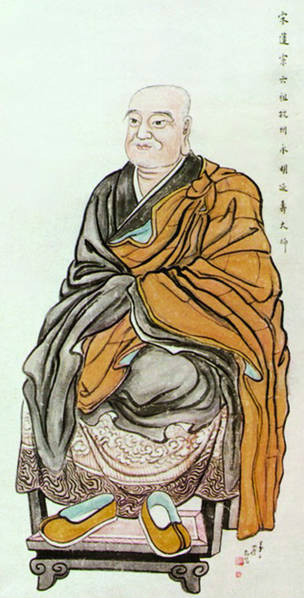
Yung-ming Yen-shou (904-975)
"From the Womb of a Cow an Elephant is Born"
(From The Transmission of the Lamp, Chüan 26)
Translated by Chang Chung-yuan
In: Original Teachings of Ch'an Buddhism. New York: Random House, 1969. p. 250-255.
CH'AN Master Chih-chio of the Yung-ming Monastery on
the Hui-jih Mountain in Hang-chou[26] was a native of
Yühang.[27] His name was Yen-shou and his original surname
was Wang. From early childhood on he believed in the teachings
of Buddhism. When he reached the age of twenty he began to
abstain from meat and only took one meal a day. He read the Lotus
Sutra[28] at exceedingly great speed, as if he were glancing at seven
columns at a time, and in about sixty days he could recite the entire
text. It was said that a number of sheep were inspired by his reading
and kneeled down to listen to him. When he was twenty-eight he
served as an officer under the general who guarded Hua-t'ing.[29]
Later Master Ts'ui-yen[30] came to stay at the Lung-ts'e Monastery
and spread the teachings of Ch'an far and wide. King Wen-mo of
Wu-yüeh[31] realized Yung-ming's devotion to Ch'an and sympathized
with the strong faith that he had in Buddhism. Therefore
the King released him from government service and let him become
a Buddhist monk. Yung-ming went to Ts'ui-yen and became his
disciple. In the temple he worked as a laborer and did all kinds of
service for the other monks, entirely forgetting himself. He never
wore silken fabrics, and when he ate he never took two dishes. He
consumed only vegetables as his daily diet, and covered himself
with a coarse cotton robe as his regular dress. Thus he passed his
days and nights.
Later he went to the T'ien-t'ai Mountain[32] and meditated under
the peak of T'ien-chu for ninety days. Little birds made their nests
in the pleats of his robe. Later on he went to visit the National
Teacher Te-chao,[33] who esteemed him highly and personally transmitted
the essence of Ch'an to him. The National Teacher told
him that because he had a spiritual affinity with the King he would
make the works of Buddhism flourish. It was secretly foretold[34]
that Yung-ming would achieve Buddhahood in the future.
Master Yung-ming first stayed at Mount Hsüeh-t'ou in Mingchou.[35]
Many disciples came to listen to him. One day the Master
said to the assembly:"Here in Hsüeh-t'ou Mountain
A rapid waterfall dashes down thousands of feet.
Here nothing stays,
Not even the tiniest chestnut.
An awesome cliff rises up thousands of feet
With no space for you to stand.
My disciples, may I ask:
Where do you proceed?"A monk asked, "A path lies in theHsüeh-t'ou Mountain. How
do you tread it?"
The Master replied:"Step by step the wintry blossom is born;
Each word is crystal clear as ice."In the first year of the Chien-lung period [A.D. 960] King Chung-i
invited him to be the first abbot of the new monastery in the Lingyin
Mountain.[36] and in the next year promoted him to be abbot of
the famous Yung-ming Monastery, as the successor of the first
abbot Ts'ui-yen. His followers numbered more than two thousand.A monk asked, "What is the profound essence of the teaching
in the Yung-ming Monastery?"
The Master answered, "Put more incense in the burner."
The questioner said, "Thank you for revealing it to me."
The Master said, "Fortunately, I had nothing to do with the
matter."The Master made the following gatha:
To know the essence of the teaching here in the Monastery of Yung-ming,
Imagine that a lake lies in front of the door.
When the sun shines upon it, a bright light is reflected.
When the wind blows, the ripples rise.The questioner asked, "I have been at the Yung-ming Monastery
for so long. Why should I still not understand the spirit of your
teachings?"
The Master answered, "You should seek understanding from
what you cannot understand."
The questioner continued, "How can I gain understanding from
what I cannot understand?"
The Master answered, "From the womb of a cow an elephant is
born; in the middle of the blue sea red dust is blown up."
The questioner asked, "There is nothing that one can attain
even though one learns to be a Buddha or a patriarch; there is also
nothing that one can attain even by going through the Karma of
Six Courses.[37] What is this that one cannot attain?"
The Master said, "Nothing can come out of what you asked."
The questioner asked, "I heard from you that all Buddhas and
their teachings came out of this sutra. What is this sutra?"
The Master answered, "Eternally revolving unceasingly, it is
neither the meaning nor the sound."
The questioner asked, "How do I receive and retain it?"
The Master answered, "If you want to receive and retain it, you
have to listen to it with your eyes."
The questioner asked, "What is the great perfect mirror?"
The Master said, "A broken earthen pot."The Master stayed for fifteen years in the Yung-ming Monastery,
which was the center for Ch'an training, and taught his
disciples, who numbered about one thousand and seven hundred.
In the seventh year of the K'ai-pao period [A.D. 974] he went to the
T'ien-t'ai Mountain and ordered that the commandment of Bodhisattva
be given to the general public. He gave food at night to
the ghosts and gods as a sacrifice. In the morning, he set many
captive birds and fish free. He spread flowers three times a day and
three times a night.
In addition to all these activities, he recited the Lotus Sutra
thirteen thousand times, compiled one hundred volumes of the
book Records of the Source Mirror, and wrote poems, gathas, and
songs, about ten thousand words in all. These writings spread widely
outside the country. When the King of Korea read the writings of
the Master, he sent his special envoy to present a letter in which
the King humbly took the position of a disciple of the Master. The
King's envoy also brought him a robe woven of gold thread, counting
beads made of purple crystal, and a golden pot, etc. Thirty-six
monks from Korea were ordained by the Master; they returned to
their native land to preach, and each became the leader of his own
district.
During the twelfth month of the eighth year of the K'ai-pao
period [975], the Master announced his sickness. On the morning of
the twenty-sixth day of the same month he burned incense and bid
good-bye to his followers. Then he sat with his legs crossed and
passed away. On the sixth day of the first month of the next year
his body was buried on Mount T'ai-tzu. His age was seventy-two. It
was then forty-two years after he had been ordained. The Emperor
T'ai-tsung of Sung bestowed upon his temple the name of Ch'an
Monastery of Everlasting Tranquillity.
NOTES
26. Hangchow, now the capital of Chekiang Province.
27. A town in northern Chekiang Province west of Hangchow.
28. Also called Miao-fa Lien-hua Ching, or The Lotus of the Wonderful Law, as translated by W. E. Soothill.
29. Now Sung-chiang (Sungkiang), a town in southern Kiangsu Province near the border of Chekiang Province.
30. Ts'ui-yen Ling-ts'an of Ming-chou. See The Lamp, Chüan 18.
31. One of ten kingdoms during Wu Tai, or The Epoch of the Five Dynasties (895-978), Wu-yüeh comprised Chekiang, southern Kiangsu, and northern Fukien provinces.
32. T'ien-t'ai Mountain is in northern Chekiang Province.
33. T'ien-t'ai Te-chao (901-972), the leading master of the second generation of the Fa-yen School. See The Lamp, Chüan 25.
34. Shou chi; in Sanskrit this ceremony is called vyakarana, which means being told that one will become a Buddha.
35. Now the city of Ningpo in northeastern Chekiang Province.
36. Near Hangchow on the Western Lake in Chekiang Province. At the foot of the mountain the Ling-yin Temple was first built during the period of Hsien-ho (326-334).
37. The Karma of Six Courses: narka-gati (hell), preta-gati (hungry ghosts), tiryagyoni-gati (animals), asura-gati (spirits), manusya-gati (human existence), deva-gati (deva existence).
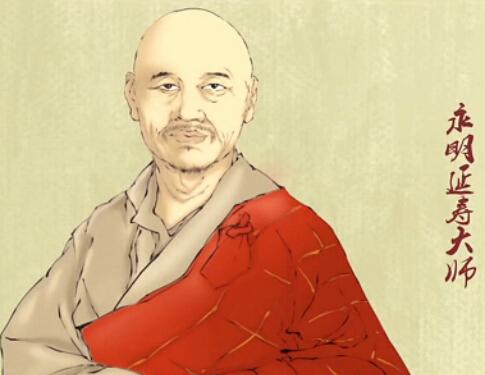
YUNG-MING
Translated by Thomas Cleary
In: The five houses of Zen, 1997
Yung-ming Yen-shou (905–976), who is also considered a patriarch of Pure Land Buddhism revitalized the study of pan-Buddhism in the Zen context and the study of Zen in the pan-Buddhism context. He was probably the most prolific Zen author of all time, especially noted for his hundred-volume compendium Source Mirror Record, in which he synthesizes the whole range of exoteric Buddhist doctrine, quoting extensively from more than three hundred classical sources.
This anthology of materials from the Five Houses of Zen closes with two selections from the work of Yen-shou of the House of Fa-yen. First is a summary critique of more than one hundred cultic deviations of Zen, following on the work of Fa-yen and others along these lines. This is followed by an instructive work on balancing the two basic aspects of meditation, commonly referred to as cessation and contemplation (or stopping and seeing) in the context of causative practice, and as concentration and insight (or stability and wisdom) in the context of effective realization. This is one of the most valuable guides to Zen meditation to be found among the literature of the Five Houses.
False Cults
BECAUSE OF IGNORANCE of the qualites of inherent nature, people fail to understand the true source. Abandoning enlightenment, they follow the dusts, giving up the root for the branches. They get hung up in the demonic web of being and nonbeing, and they wander in the forest of errors of oneness and difference. Trying to master true emptiness, they become alienated from the nature of reality; based on the arising and disappearance of sense data, they follow the being and nothingness of objects. Clinging to nihilism, confused by eternalism, they pursue the conditional and forget the essential. Mistakenly developing intellectual interpretation, they cultivate practice wrongly.
Some mellow the spirit, nurture energy, and preserve naturalness. Some torture the body, mortifying the flesh, and consider that the ultimate path.
Some cling to nongrasping and stand rooted in the immediate environment. Some suppress the wandering mind in quest of quiet meditation.
Some get rid of feelings and negate phenomena in order to stabilize voidness. Some stick to reflections, get involved in objects, and embrace forms.
Some extinguish the true radiance of the spiritual source. Some eliminate the true causal basis of Buddhist principles.
Some cut off consciousness and freeze the mind, experiencing an inanimate state in consequence. Some clear the mind and ignore matter, abiding as a result in a kind of celestial state in which it is hard to become enlightened.
Some stick to phantasms, clinging to their existence. Some become complete nihilists.
Some eliminate all views and dwell in dark rooms. Some insist on perception and dwell on cognition.
Some consider having awareness to be the form of the true Buddha. Some imitate insentience, like wood or stone.
Some cling to illusion as if it were the same as the ultimate realization, like considering clay in itself to be a jar. Some seek ways of liberation wrongly focused, like seeking water while rejecting waves.
Some hasten outwardly and deludedly produce dream states. Some keep to inwardness and live in solemnity, embracing ignorance.
Some are devoted to oneness and consider everything the same. Some see differences and define individual reality-realms.
Some keep to ignorant nondiscrimination and consider that the Great Way. Some value the notion of voidness and consider denial of good and bad to be true practice.
Some interpret inconceivability to be insensate voidness. Some understand true goodness and subtle form to be really existent.
Some stop mental workings and cut off thoughts, like angels with polluted minds. Some contemplate with awareness and attention, falling within the bounds of intellectual assessment.
Some fail to investigate the nature of illusion thoroughly, interpreting it as the unknown beginning. Some are ignorant of illusory substance and make a religion of nothingness.
Some recognize reflections as realities. Some seek reality while clinging to falsehood.
Some recognize the nature of perception as a living thing. Some point to illusory objects as inanimate.
Some willfully entertain ideas and turn away from silent knowledge. Some cut off thoughts and thus lack enlightened function.
Some lose sight of natural qualities and conceive views of matter and mind. Some rely on ultimate emptiness and develop a nihilistic attitude.
Some cling to universal principle and immediately abandon adornment. Some misunderstand gradual teaching and become fanatical activists.
Some detach from objects by relying on essence but make their attachment to self stronger. Some ignore everything and maintain themselves in ignorance.
Some decide that persons and phenomena are as they are naturally, and fall into the idea that there is no causality. Some cling to the combination of objects and intellect and conceive the notion of collective causality.
Some cling to the mixing of mind and objects, confusing subjective and objective actualities. Some stick to distinguishing absolute and conventional, bound up in the folly of obstruction by knowledge.
Some adhere to unchanging oneness, thus falling into eternalism. Some determine the movement of origin, abiding, decay, and nothingness, thus sinking into nihilism.
Some cling to noncultivation and thus dismiss the ranks of sages. Some say there is realization, and thus turn away from natural reality.
Some delight in the environment and their own persons, thus following the routines of the world. Some reject life and death and thus lose true liberation.
Some, misunderstanding true emptiness, are devoted to causes and obsessed with results. Some, ignorant of ultimate reality, long for enlightenment and despise bewilderment.
Some cling to expedient statements, holding to them as literal truth. Some lose the reality of verbal expression and seek silence apart from words.
Some are devoted to doctrinal methods and disdain spontaneous meditation. Some promote meditative contemplations and repudiate the measuring devices of the complete teaching.
Some compete at being extraordinary while only being concerned with status, suddenly sinking in the sea of knowledge. Some contrive purity to find out hidden secrets, instead getting trapped within a realm of shadows.
Some produce extraordinary intellectual interpretations, gouging flesh and producing wounds. Some dwell on original essential purity but cling to the medicine so it becomes unhealthy.
Some pursue the literature, searching out meanings, and wind up drinking a flood. Some keep to stillness and live in isolation, sitting in the dust of dogma.
Some discuss the formless Great Vehicle with the idea of getting something. Some search for mystic truth outside of things by means of calculating thoughts.
Some reject explanation and conceive the notion of absolute nonverbalization. Some keep explanation and call on the criticism of clinging to the pointing finger.
Some approve of active function and remain at the root source of birth and death. Some concentrate on memorization, dwelling within the limits of conscious thinking.
Some lose the essence of complete awareness by modification and adjustment. Some let be whatever will be, and lack a method of entering the path.
Some initiate energetic physical and mental efforts and linger in contrivance. Some keep to letting be without concern and sink into the bondage of insight.
Some concentrate on focusing thoughts and contemplating diligently, thus losing correct reception. Some imitate uninhibited freedom and give up cultivation.
Some follow binding compulsions while presuming upon intrinsic emptiness. Some cling to bondage and try to eliminate it arbitrarily.
Some are so serious that they develop attachment to religion. Some are so flippant that they ruin the basis of enlightenment.
Some seek so aggressively that they turn away from the original mind. Some slack off and become heedless.
Some lack realism, their speech and their realization differing. Some violate the vehicle of enlightenment by disparity of being and action.
Some keep to tranquillity, dwelling in emptiness, thereby losing the nature of great compassion. Some ignore conditions and reject the temporal, thus missing the door of naturalness.
Some stick to the notion of self, thus being ignorant of the emptiness of person. Some confuse immediate experience and harden their attachment to doctrine.
Some interpret without having faith, increasing false views. Some have faith but no understanding, increasing ignorance.
Some affirm the subjective but deny the objective. Some claim states are deep while knowledge is shallow.
Some get confused about the nature of things by grasping. Some turn away from immediate reality by rejection.
Some violate cause because of detachment. Some forget consequences because of attachment.
Some repudiate reality by denial. Some ruin temporary expedients by affirmation.
Some hate ignorance but thereby turn their backs on the door of immutable knowledge. Some dislike varying states but thereby destroy absorption in the nature of reality.
Some base themselves on the principle of sameness but thereby develop conceit. Some dismiss differentiations, thus destroying the methods of expedient techniques.
Some affirm enlightenment but repudiate the cycle of true teaching. Some deny sentient beings and repudiate the true body of Buddha.
Some stick to basic knowledge and deny expedient wisdom. Some miss the true source and cling to temporary methods.
Some linger in noumenon, sinking into a pit of inaction. Some cling to phenomena, throwing themselves into the net of illusion.
Some annihilate boundaries and obliterate tracks, turning away from the door of dual illumination. Some maintain rectitude, keeping to the center, but lose the sense of expedient technique.
Some cultivate concentration or insight one-sidedly, without balance, thus rotting the sprouts of the path. Some carry out vows all alone, burying the family of the enlightened.
Some work on the practice of inaction to cultivate fabricated enlightenment. Some cling to the nonclinging mind, learning imitation insight.
Some aim for purity, misunderstanding the true nature of defilement. Some dwell on the absolute and lose the basic emptiness of the mundane.
Some practice formless contemplation, blocking true suchness. Some conceive a sense of knowing but thereby turn away from the essence of reality.
Some stick by true explanation but develop literalistic views. Some drink the elixir of immortality yet die young.
Some are so earnest about the principle of completeness that they develop an attitude of clinging attachment; they drink the nectar but turn it into poison.
The foregoing has been a brief notice of one hundred twenty kinds of views and understandings characteristic of false cults. All of them have lost the source and turned away from the essential message.
The Cooperation of Concentration and Insight
In Zen and the Teachings there are two methods, most honored of the myriad practices of ten perfections. At first they are called stopping and seeing, to help new learners; later they become concentration and wisdom, roots of enlightenment.
These are only one reality, which seems to have two parts. In the silence of the essence of reality is stopping by comprehending truth; when silent yet ever aware, subtle seeing is there.
Concentration is the father, insight the mother; they can conceive the thousand sages, developing their faculties and powers, nurturing their sacred potential, giving birth to buddhas and Zen masters in every moment of thought.
Concentration is the general, insight the minister; they can assist the mind monarch in attaining the unexcelled, providing forever means for all to realize the Way, in the manner of the enlightenment of the ancient buddhas.
Concentration is like the moonlight shining so brightly that the stars of errant falsehood vanish. If you can hold up the torch of knowledge, so much the clearer. Irrigating the sprouts of enlightenment, it removes emotional bondage.
Insight is like the sun shining, breaking up the darkness of ignorance. It is able to cause the Zen of the ignorant with false views to turn into transcendent wisdom.
A brief time of silence, a moment of stillness, gradually build up into correct concentration. The sages, making comparatively little effort, ultimately saw the subtle essence of the pedestal of the spirit.
As soon as you hear even a little bit of the Teaching, it can influence your subconscious such that seeds of awakening develop. The moment you turn the light of awareness around, accurate cognition opens up; in an instant you can accomplish Buddha’s teaching like this.
The power of meditative concentration is inconceivable; it changes the ordinary into sages instantly. Boundless birth and death is thereby severed at the root; the nest of accumulated ages of mundane toils is destroyed. This is the water that stills the mind, the pearl that purifies the will; its light engulfs myriad forms, lighting a thousand roads.
When you open your own eyes, there are no obstructions; originally there is nothing in the world that constrains. When thieves of attention and reflection are quelled in a timely manner, then the sickness of obsession with objects suddenly clears up.
Washing away the dirt of thoughts and cleaning away the dust of confusion reveals the body of reality and strengthens the life of wisdom. Like an immutable mountain, like a still sea, even if the sky should flip and the earth overturn, you would not be changed. Bright as crystal imbued with moonlight, serene and unbound, you are independent.
No one can measure the insight of wisdom; it naturally manifests the light of the mind according to the occasion. It is the leader of myriad practices, the spiritual ruler at all times. It evaporates the ocean of misery and shatters the mountains of falsehood.
When the clouds of illusion withdraw completely for a while, the gold in the poor woman’s house shows up all at once, and the pearl embedded in the wrestler’s forehead re-emerges. Cutting through the web of folly, interrupting the flow of desires, the awesome power of the great hero has no peer; it can cool the iron beds and copper stakes of hell and cause the results of the actions of demons and antagonists to cease. Settling disputes, fulfilling honor and justice, everywhere it shows people the wisdom of the buddhas. Biased and perverted knowledge is all subordinated to the source; both the smallest and the greatest alike receive direction.
One-sided cultivation of concentration is pure yin; it corrodes people and erodes right livelihood. If you use accurate insight to illuminate meditation, all things will naturally be clear as a mirror.
One-sided cultivation of insight is pure yang; it withers people and makes them linger on the way. You should use subtle concentration to help contemplative exercise, like the clear light of the moon removing a film of mist.
I recommend equal cultivation of concentration and insight, not one-sided practice. They are originally one entity, not two things. It is like a bird flying through the sky with two wings, or like a chariot drawn on two wheels. Thus in the course of ordinary life you climb up onto the shore of awakening, then sail the boat of compassion on the ocean of karma.
There is concentration on the concrete, in which everything is accomplished by placing the mind on one point. There is concentration on the abstract, in which one must only look directly into the essential nature of mind.
There is contemplation of the concrete, in which one clarifies the characteristics of things and develops judgment. There is contemplation of the abstract, in which it is suddenly realized there is no One and no Beyond.
Insofar as concentration itself is insight, they are not one, not two, not any calculation of mind. Insofar as insight itself is concentration, they are not the same, not different, beyond looking and listening.
Sometimes they are operated together, so you are tranquil yet perceptive, penetrating the teaching of the real. Sometimes they both disappear; neither concentration nor insight, this transcends ordinary standards.
Entering concentration in one atom and arising from it in a multitude of atoms is something natural in the context of transcendent insight. While absorbed in the state of a child, you discuss the laws of reality in the state of an elderly person. If you can see into a single object, all objects are the same; an atom near at hand or a land far away—all are comprehended. On the road of true suchness, you discourse on birth and death; in the ocean of ignorance, you expound the complete religion. The eye can do the enlightened work of the nose; entering concentration in an atom of matter, you arise from concentration in an atom of scent.
Mind and objects are always the same; it is views that differ. Who speaks of not working on cultivation—waves are originally water. Neither silent nor shining, beyond words and thought, yet tranquil and perceptive, effective without compare: temporal and true both carried out, you open the right road; substance and function helping each other, you embody the subtle message.
I urge you not to throw away time, for it’s swift as an arrow, fast as a stream. Distraction is entirely due to lack of concentration; stupidity and blindness are caused by lack of true knowledge.
Genuinely true words should be admitted into the ears. A thousand scriptures and ten thousand treatises indicate the same thing: the total effect of concentration and insight should never be forgotten—in a single moment you return at once to the state of real awakeness.
Concentration needs practice; insight needs learning. Don’t let the spiritual pedestal be dimmed at all.
A massive tree grows from a tiny sprout; effective work gradually accumulated produces value and excellence. Even an ape that learns concentration is born in a heavenly realm; a little girl, with a moment’s thought, enters the door of the Way.
When you can help yourself and also help others, then cause and effect are fulfilled; no one can talk of doing this without concentration and insight.
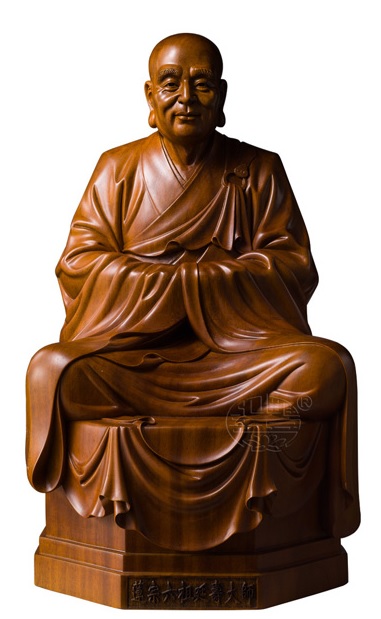
YONGMING YANSHOU
IN: Zen's Chinese heritage: the masters and their teachings
by Andy Ferguson
Boston: Wisdom Publications, 2000. pp. 397-399.
YONGMING YANSHOU (904–75) was a disciple of Tiantai Deshao. He came from ancient Yuhang (located near Hangzhou City in Zhejiang Province). A brilliant and devoted practitioner of Buddhism, Yongming is honored as the third ancestor of the Fayan lineage of Zen, as well as the sixth ancestor of Chinese Pure Land Buddhism. He left home at the relatively late age of thirty to study under Zen master Cuiyan Lingcan at Longce Temple.182 Later, he undertook intensive Zen meditation practices under National Teacher Deshao on Mt. Tiantai, becoming his Dharma heir in the Fayan Zen lineage. The Wudeng Huiyuan relates that Yanshou remained so still during a ninety-day meditation session that a bird built a nest in the folds of his motionless clothing. Sometime later, Yanshou moved to nearby Guoqing Temple, where he undertook the Pure Land practice of chanting and other austerities.183
Yongming assumed his first position of abbot at Mt. Xuedou. Later, he moved to Hangzhou, where he restored Lingyin Monastery, a major temple that remains a national attraction in China. At the invitation of the ruler, Yanshou then moved to Yongming Monastery on the south shore of Hangzhou's West Lake. He remained there for fifteen years, receiving the mountain name by which he is remembered.
Yongming, as the occasion required, taught using both Zen and Pure Land methods of instruction. Like the Fayan school's founder, Fayan Wenyi, Yongming's syncretic method of instruction presaged the wide dilution of Zen with other Buddhist schools that occurred as the Song dynasty proceeded. A huge congregation gathered around him, and in his own era he was called an incarnation of Maitreya Bodhisattva. He worked closely with leaders of the Faxiang, Huayan, and Tiantai Buddhist sects to assemble the records and writings of more than two hundred famous Indian and Chinese Buddhist teachers.184 The king of Korea paid tribute to these texts by sending Yongming various gifts. He also dispatched thirty-six monks to Hangzhou to study under this eminent teacher. Each of these foreign monks is said to have received Yanshou's Dharma seal and then returned to Korea, extending the teachings of the Fayan school into that country.
Zen master Yongming Yanshou addressed the monks, saying, “This place, Xuedou, has erupted eight thousand feet into the air and the earth has turned into slippery grain, stacked in a freakish eighty-thousand-foot peak. You have absolutely nothing firm upon which to stand. In what direction will you step forward?”
A monk asked Yongming, “How can one walk upon the path of Xuedou?”
Yanshou said, “Step by step through the wondrous cold landscape; words entirely frozen.”
Yongming recited the following verse:
Amid the high peaks a forlorn ape cries down to the moon.
The recluse chants while half the night candle burns.
Who comprehends this place and time?
At a place deep within white clouds, a Zen monk sits.
A monk asked, “What is Yongming's wondrous mystery?”
Yanshou said, “Add more incense.”
The monk said, “Thank you, Master, for your instruction.”
Yanshou said, “So you're satisfied and don't want to delve deeper?”
The monk bowed.
Yanshou said, “Listen to this verse:
If you desire to know Yongming's mystery,
Before the gate is the lake's surface.185
The sun illuminates all life.
The wind arises and waves come up.”
A monk asked, “This student has long been here at Yongming. Why can't I understand the style of the Yongming House?”
Yongming said, “You can understand the place you don't understand.”
The monk said, “How can I understand what I don't understand?”
Yongming said, “An ox gives birth to an elephant. The blue sea gives rise to red dust.”
A monk asked, “Our tradition has the saying, ‘All the buddhas and their teachings come forth from this scripture.' What is ‘this scripture'?”
Yongming said, “Without intention or sound it is endlessly recited.”
The monk asked, “How does one receive and uphold it?”
Yongming said, “Those who want to receive and uphold it must look and listen.”
A monk asked, “What is the great perfect mirror?”
Yongming said, “A broken dish of sand.”
During the twelfth month of [the year 975], Yongming became ill. Two days later he bade the monks farewell. Sitting cross-legged in an upright position, he passed away. His stupa was placed on Dazi [“Great Compassion”] Mountain.
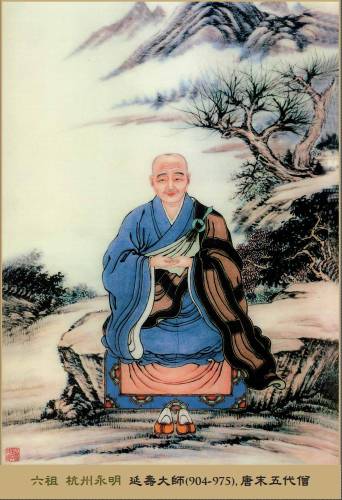
六祖 杭州永明 延壽大師 (904-975), 唐末五代僧
淨宗十三祖
The Axiom of the One-Mind: Li (“Principle”) and Yongming Yanshou's Ontological Paradigm
MA Thesis by Keenan W. Cox
McMaster University,
Hamilton, Ontario, 2014
https://macsphere.mcmaster.ca/bitstream/11375/16409/1/Keenan%20Cox%20MA%20Thesis%20Final.pdf
Zen Lore from the Source Mirror
compiled by Zen Master Yen-shou
Translated by J. C. Cleary
N.p.: Nanyang Books, 1979. 36 p.
Commentaries on the 98th scroll of the Zongjing lu by Zen master Yanshou (904-975).